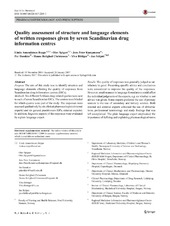| dc.contributor.author | Reppe, Linda Amundstuen | en_US |
| dc.contributor.author | Spigset, Olav | en_US |
| dc.contributor.author | Kampmann, Jens Peter | en_US |
| dc.contributor.author | Damkier, Per | en_US |
| dc.contributor.author | Christensen, Hanne Rolighed | en_US |
| dc.contributor.author | Böttiger, Ylva | en_US |
| dc.contributor.author | Schjøtt, Jan | en_US |
| dc.date.accessioned | 2017-11-06T13:53:41Z | |
| dc.date.available | 2017-11-06T13:53:41Z | |
| dc.date.issued | 2017-05 | |
| dc.Published | Reppe L, Spigset O, Kampmann JP, Damkier P, Christensen HR, Böttiger Y, Schjøtt JS. Quality assessment of structure and language elements of written responses given by seven Scandinavian drug information centres.. European Journal of Clinical Pharmacology. 2017;73(5):623-631 | eng |
| dc.identifier.issn | 1432-1041 | |
| dc.identifier.issn | 0031-6970 | |
| dc.identifier.uri | https://hdl.handle.net/1956/16852 | |
| dc.description.abstract | Purpose: The aim of this study was to identify structure and language elements affecting the quality of responses from Scandinavian drug information centres (DICs). Methods: Six different fictitious drug-related queries were sent to each of seven Scandinavian DICs. The centres were blinded for which queries were part of the study. The responses were assessed qualitatively by six clinical pharmacologists (internal experts) and six general practitioners (GPs, external experts). In addition, linguistic aspects of the responses were evaluated by a plain language expert. Results: The quality of responses was generally judged as satisfactory to good. Presenting specific advice and conclusions were considered to improve the quality of the responses. However, small nuances in language formulations could affect the individual judgments of the experts, e.g. on whether or not advice was given. Some experts preferred the use of primary sources to the use of secondary and tertiary sources. Both internal and external experts criticised the use of abbreviations, professional terminology and study findings that was left unexplained. The plain language expert emphasised the importance of defining and explaining pharmacological terms to ensure that enquirers understand the response as intended. In addition, more use of active voice and less compressed text structure would be desirable. Conclusions: This evaluation of responses to DIC queries may give some indications on how to improve written responses on drug-related queries with respect to language and text structure. Giving specific advice and precise conclusions and avoiding too compressed language and non-standard abbreviations may aid to reach this goal. | en_US |
| dc.language.iso | eng | eng |
| dc.publisher | Springer | eng |
| dc.rights | Attribution CC BY | eng |
| dc.rights.uri | http://creativecommons.org/licenses/by/4.0 | eng |
| dc.subject | Quality assurance | eng |
| dc.subject | Health care | eng |
| dc.subject | Drug information services | eng |
| dc.subject | Information literacy | eng |
| dc.title | Quality assessment of structure and language elements of written responses given by seven Scandinavian drug information centres | en_US |
| dc.type | Peer reviewed | |
| dc.type | Journal article | |
| dc.date.updated | 2017-10-04T07:09:57Z | |
| dc.description.version | publishedVersion | en_US |
| dc.rights.holder | Copyright 2017 The Author(s) | |
| dc.identifier.doi | https://doi.org/10.1007/s00228-017-2209-3 | |
| dc.identifier.cristin | 1447297 | |
| dc.source.journal | European Journal of Clinical Pharmacology | |

